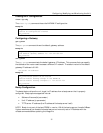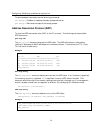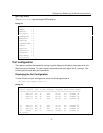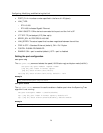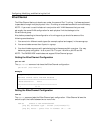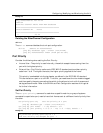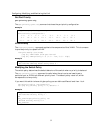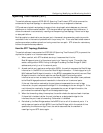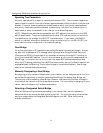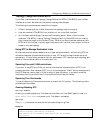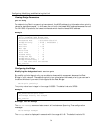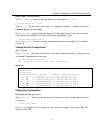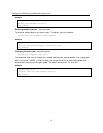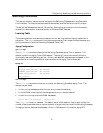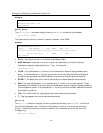
Configuring, Modifying, and Monitoring the Unit
33
Spanning Tree Protocol (STP)
The switch software supports IEEE 802.1D Spanning Tree Protocol (STP) which ensures the
existence of a loop-free topology in networks that contain any arrangement of devices.
STP produces a logical tree topology to ensure that a single path exists between any two end
stations on an interconnected network. STP also provides a high degree of fault tolerance. It
allows the network to automatically reconfigure the spanning tree topology if there is a bridge
or data-path failure.
Multiple paths to a destination can be good, as in the case of using secondary paths to provide
redundant links in the event of problems with the primary link. It can also lead to bad network
performance when problems arise from having more than one path. STP allows for redundancy
without the performance problems.
How the STP Topology Stabilizes
The switch software incorporates the IEEE 802.1D Spanning Tree Protocol (STP) to prevent the
duplication of paths in an interconnected network.
1. When a switch, with STP enabled, starts up, it assumes that it is the
Root Bridge and puts all of its external ports into “listening” mode. The switch then
sends a configuration BPDU listing its bridge ID as being the Root Bridge ID (MAC
address and priority) on all its external ports.
2. As each switch port receives a configuration BPDU, the switch compares the Root Bridge
information in the BPDU to its current Root Bridge information. If the bridge priority or
MAC address Root Bridge information in the BPDU supersedes the switch’s current Root
Bridge information, the switch sets the new Root Bridge ID and configuration
information as current and sets the root interface. The switch then adds it own pathcost
to the Root Bridge pathcost and resends this information on its external ports.
If the root information received by the port does not supersede the current bridge
information, the port compares the bridge ID in the message to its own bridge ID. If the
root information received by the port supersedes the current bridge information, the
port makes the received bridge ID as the designated bridge.
3. When the forwarding delay time expires, the switch checks the status of each interface.
If the switch interface is either the root interface or a designated bridge for the
interface, the port is set to forwarding. Otherwise it is blocked.
4. Periodically, the Root Bridge sends a Hello BPDU out on all of its external ports. If a
switch does not receive a Hello BPDU from the Root Bridge, within the period of time
specified by the Maximum Age Timer, the switch assumes that the network is
reconfiguring and STP starts again.



